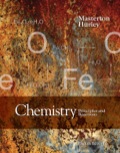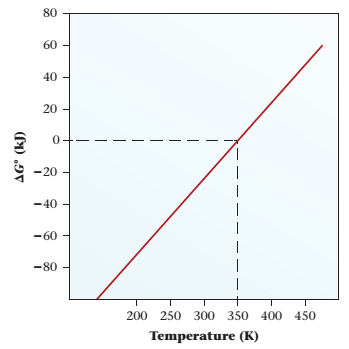
EBK CHEMISTRY: PRINCIPLES AND REACTIONS
8th Edition
ISBN: 8220100547966
Author: Hurley
Publisher: CENGAGE L
expand_more
expand_more
format_list_bulleted
Textbook Question
Chapter 16, Problem 90QAP
Consider the graph below:
(a) Describe the relationship between the spontaneity of the process and temperature.
(b) Is the reaction exothermic?
(c)
(d) At what temperature is the reaction at standard conditions likely to be at equilibrium?
(e) Estimate K for the reaction at 97°C.
Expert Solution & Answer
Want to see the full answer?
Check out a sample textbook solution
Students have asked these similar questions
In one electrode: Pt, H2(1 atm) | H+(a=1), the interchange current density at 298K is 0.79 mA·cm-2. If the voltage difference of the interface is +5 mV. What will be the correct intensity at pH = 2?. Maximum transfer voltage and beta = 0.5.
In a Pt electrode, H2(1 atm) | H+(a=1), the interchange current density of an electrode is 0.79 mA cm-2. ¿Qué corriente flow across the electrode of área 5 cm2 when the difference in potential of the interface is +5 mV?.
If the current voltage is n = 0.14 V, indicate which of the 2 voltage
formulas of the ley of Tafel must be applied
i
a
a) == exp (1-B).
xp[(1 - ß³):
Fn
Fn
a
b) == exp B
RT
RT
Chapter 16 Solutions
EBK CHEMISTRY: PRINCIPLES AND REACTIONS
Ch. 16 - Spontaneous Processes Which of the following...Ch. 16 - Which of the following processes are spontaneous?...Ch. 16 - Which of the following processes are spontaneous?...Ch. 16 - Which of the following processes are spontaneous?...Ch. 16 - On the basis of your experience, predict which...Ch. 16 - On the basis of your experience, predict which of...Ch. 16 - In each of the following pairs, choose the...Ch. 16 - In each of the following pairs, choose the...Ch. 16 - Predict the sign of ΔS for the following: (a) a...Ch. 16 - Predict the sign of S for the following: (a)...
Ch. 16 - Predict the sign of S for each of the following...Ch. 16 - Predict the sign of S for each of the following...Ch. 16 - Predict the sign of S for each of the following...Ch. 16 - Predict the sign of S for each of the following...Ch. 16 - Predict the order of the following reactions in...Ch. 16 - Predict the order of the following reactions in...Ch. 16 - Use Table 16.1 to calculate S for each of the...Ch. 16 - Prob. 18QAPCh. 16 - Use Table 16.1 to calculate S for each of the...Ch. 16 - Use Table 16.1 to calculate S for each of the...Ch. 16 - Prob. 21QAPCh. 16 - Prob. 22QAPCh. 16 - Calculate G at 82C for reactions in which (a)...Ch. 16 - Calculate G at 72C for reactions in which (a)...Ch. 16 - Calculate G at 355 K for each of the reactions in...Ch. 16 - Calculate G at 415 K for each of the reactions in...Ch. 16 - From the values for G f given in Appendix 1,...Ch. 16 - Follow the directions of Problem 27 for each of...Ch. 16 - Use standard entropies and heats of formation to...Ch. 16 - Follow the directions of Question 29 for the...Ch. 16 - It has been proposed that wood alcohol, CH3OH, a...Ch. 16 - Prob. 32QAPCh. 16 - Sodium carbonate, also called washing soda, can be...Ch. 16 - The reaction between magnesium metal and water (l)...Ch. 16 - In the laboratory, POCl3 (phosphorus oxychloride)...Ch. 16 - Oxygen can be made in the laboratory by reacting...Ch. 16 - Phosgene, COCl2, can be formed by the reaction of...Ch. 16 - When permanganate ions in aqueous solution react...Ch. 16 - Discuss the effect of temperature change on the...Ch. 16 - Discuss the effect of temperature on the...Ch. 16 - At what temperature does G become zero for each of...Ch. 16 - Over what temperature range are the reactions in...Ch. 16 - For the reaction...Ch. 16 - For the reaction...Ch. 16 - For the decomposition of Ag2O:...Ch. 16 - Consider the following hypothetical equation...Ch. 16 - Prob. 47QAPCh. 16 - Prob. 48QAPCh. 16 - Red phosphorus is formed by heating white...Ch. 16 - Organ pipes in unheated churches develop tin...Ch. 16 - Prob. 51QAPCh. 16 - Pencil lead is almost pure graphite. Graphite is...Ch. 16 - Given the following data for sodium Na(s): S =51.2...Ch. 16 - Given the following data for bromine: Br2(l); S...Ch. 16 - Show by calculation, using Appendix 1, whether...Ch. 16 - Show by calculation whether the reaction HF(aq)...Ch. 16 - For the reaction...Ch. 16 - For the reaction...Ch. 16 - Consider the reaction 2SO2(g)+O2(g)2SO3(g) (a)...Ch. 16 - Consider the reaction AgCl(s)Ag+(aq)+Cl(aq) (a)...Ch. 16 - Consider the reaction CO(g)+H2O(g)CO2(g)+H2(g) Use...Ch. 16 - Consider the reaction NH4+(aq) H+(aq)+NH3(aq) Use ...Ch. 16 - Consider the following reaction at 25C:...Ch. 16 - Consider the reaction N2O(g)+NO2(g)3NO(g)K=4.41019...Ch. 16 - For the reaction...Ch. 16 - Consider the decomposition of N2O4 at 100C....Ch. 16 - Use the values for G f in Appendix 1 to calculate...Ch. 16 - Given that H f for HF(aq) is -320.1 kJ/mol and S...Ch. 16 - At 25C, a 0.327 M solution of a weak acid HX has a...Ch. 16 - A 0.250 M solution of a weak base R2NH has a pH of...Ch. 16 - Prob. 71QAPCh. 16 - Given the following standard free energies at 25°C...Ch. 16 - Natural gas, which is mostly methane, CH4, is a...Ch. 16 - Prob. 74QAPCh. 16 - When glucose, C6H12O11, is metabolized to CO2 and...Ch. 16 - Consider the following reactions at 25°C:...Ch. 16 - At 1200 K, an equilibrium mixture of CO and CO2...Ch. 16 - Prob. 78QAPCh. 16 - Prob. 79QAPCh. 16 - Prob. 80QAPCh. 16 - Prob. 81QAPCh. 16 - Carbon monoxide poisoning results when carbon...Ch. 16 - Prob. 83QAPCh. 16 - Determine whether each of the following statements...Ch. 16 - Which of the following quantities can be taken to...Ch. 16 - Fill in the blanks: (a) H° and G° become equal at...Ch. 16 - Fill in the blanks: (a) At equilibrium, G is. (b)...Ch. 16 - Prob. 88QAPCh. 16 - Consider the following reaction with its...Ch. 16 - Consider the graph below: (a) Describe the...Ch. 16 - Prob. 91QAPCh. 16 - Prob. 92QAPCh. 16 - Prob. 93QAPCh. 16 - Hf for iodine gas is 62.4 kJ/mol, and S° is 260.7...Ch. 16 - Prob. 95QAPCh. 16 - The overall reaction that occurs when sugar is...Ch. 16 - Hydrogen has been suggested as the fuel of the...Ch. 16 - When a copper wire is exposed to air at room...Ch. 16 - Kafor acetic acid (HC2H3O2) at 25°C is 1.754105 ....Ch. 16 - Consider the reaction 2HI(g)H2(g)+I2(g)At 500C a...Ch. 16 - Prob. 101QAPCh. 16 - Consider the formation of HI(g) from H2(g) and...
Knowledge Booster
Learn more about
Need a deep-dive on the concept behind this application? Look no further. Learn more about this topic, chemistry and related others by exploring similar questions and additional content below.Similar questions
- If the current voltage is n = 0.14 V. Indicate which of the 2 formulas must be applied a) = a T = i exp[(1 - p) F Fn Fn b) i==exp B RTarrow_forwardTopic: Photochemistry and Photophysics of Supramoleculesarrow_forwardTwo cations that exchange an electron in an interface, the exchange density is worth 1.39 mA/cm2 and the current density is worth 15 mA/cm2 at 25°C. If the overvoltage is 0.14 V, calculate the reaction rate and symmetry factor. Data: R = 8,314 J mol-1 k-1: F = 96500 Carrow_forward
- With the help of the Tafel line, it is estimated that the interchange density of the VO2+/VO2+ system on the carbon paper has a value of 3 mA cm-2. Calculate a) the current density if the voltage has a value of 1.6 mV and the temperature is 25°C. b) the beta value of the anódico process if the Tafel pendulum is 0.6 V at 25°C. Data: R = 8.314 JK-1mol-1, y F = 96485 C mol-1.arrow_forwardApply the NANSTE law to the MnO4- + 8H+ + 5e- ⇄ Mn2+ + 4H2Oarrow_forwardIn the Nernst Law, how much is RT / F?arrow_forward
arrow_back_ios
SEE MORE QUESTIONS
arrow_forward_ios
Recommended textbooks for you
 Principles of Modern ChemistryChemistryISBN:9781305079113Author:David W. Oxtoby, H. Pat Gillis, Laurie J. ButlerPublisher:Cengage Learning
Principles of Modern ChemistryChemistryISBN:9781305079113Author:David W. Oxtoby, H. Pat Gillis, Laurie J. ButlerPublisher:Cengage Learning Chemistry: The Molecular ScienceChemistryISBN:9781285199047Author:John W. Moore, Conrad L. StanitskiPublisher:Cengage Learning
Chemistry: The Molecular ScienceChemistryISBN:9781285199047Author:John W. Moore, Conrad L. StanitskiPublisher:Cengage Learning Chemistry: Principles and ReactionsChemistryISBN:9781305079373Author:William L. Masterton, Cecile N. HurleyPublisher:Cengage Learning
Chemistry: Principles and ReactionsChemistryISBN:9781305079373Author:William L. Masterton, Cecile N. HurleyPublisher:Cengage Learning ChemistryChemistryISBN:9781305957404Author:Steven S. Zumdahl, Susan A. Zumdahl, Donald J. DeCostePublisher:Cengage Learning
ChemistryChemistryISBN:9781305957404Author:Steven S. Zumdahl, Susan A. Zumdahl, Donald J. DeCostePublisher:Cengage Learning Chemistry: An Atoms First ApproachChemistryISBN:9781305079243Author:Steven S. Zumdahl, Susan A. ZumdahlPublisher:Cengage Learning
Chemistry: An Atoms First ApproachChemistryISBN:9781305079243Author:Steven S. Zumdahl, Susan A. ZumdahlPublisher:Cengage Learning

Principles of Modern Chemistry
Chemistry
ISBN:9781305079113
Author:David W. Oxtoby, H. Pat Gillis, Laurie J. Butler
Publisher:Cengage Learning

Chemistry: The Molecular Science
Chemistry
ISBN:9781285199047
Author:John W. Moore, Conrad L. Stanitski
Publisher:Cengage Learning

Chemistry: Principles and Reactions
Chemistry
ISBN:9781305079373
Author:William L. Masterton, Cecile N. Hurley
Publisher:Cengage Learning

Chemistry
Chemistry
ISBN:9781305957404
Author:Steven S. Zumdahl, Susan A. Zumdahl, Donald J. DeCoste
Publisher:Cengage Learning

Chemistry: An Atoms First Approach
Chemistry
ISBN:9781305079243
Author:Steven S. Zumdahl, Susan A. Zumdahl
Publisher:Cengage Learning

The Laws of Thermodynamics, Entropy, and Gibbs Free Energy; Author: Professor Dave Explains;https://www.youtube.com/watch?v=8N1BxHgsoOw;License: Standard YouTube License, CC-BY